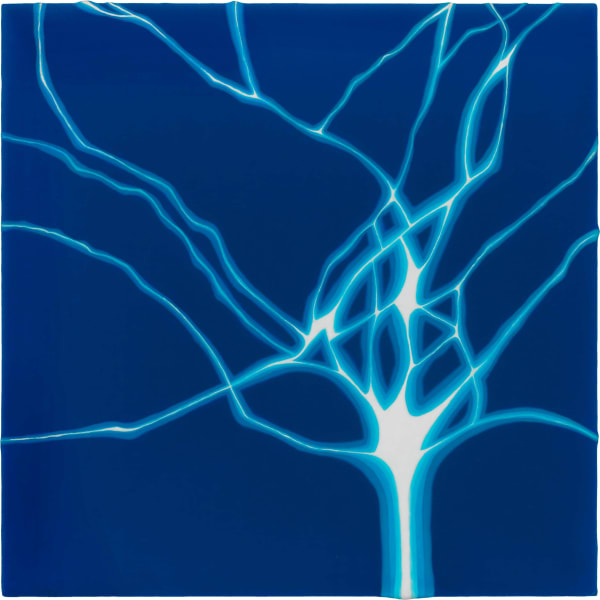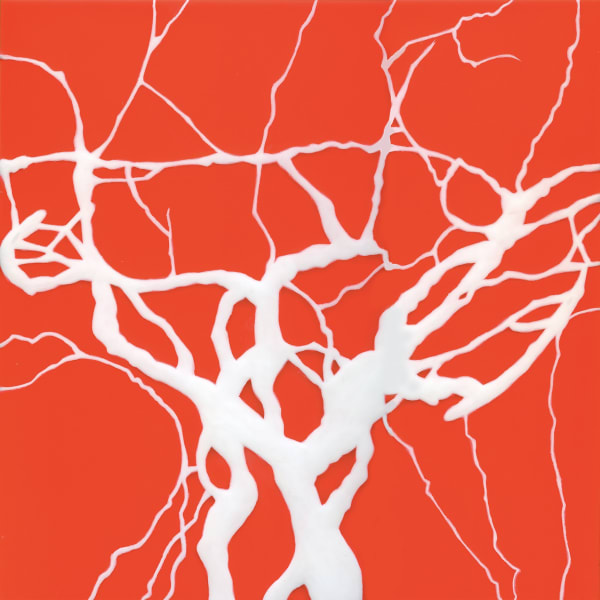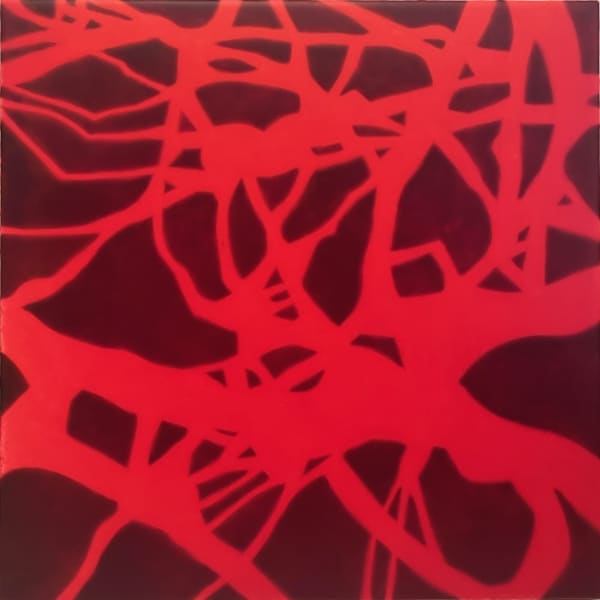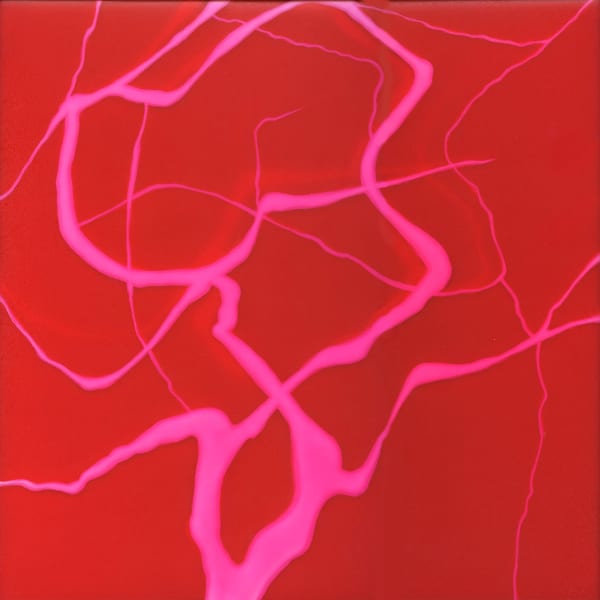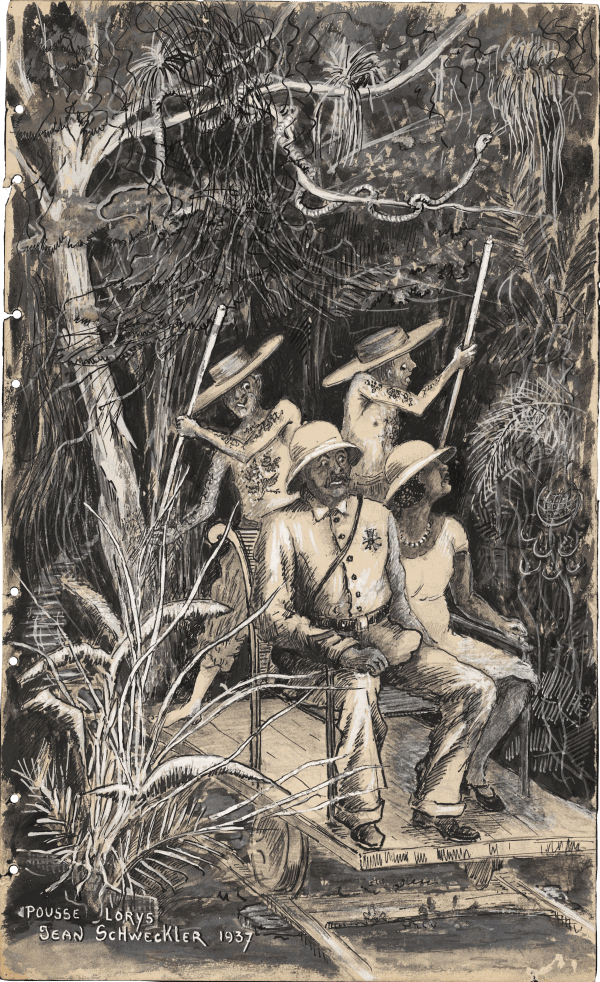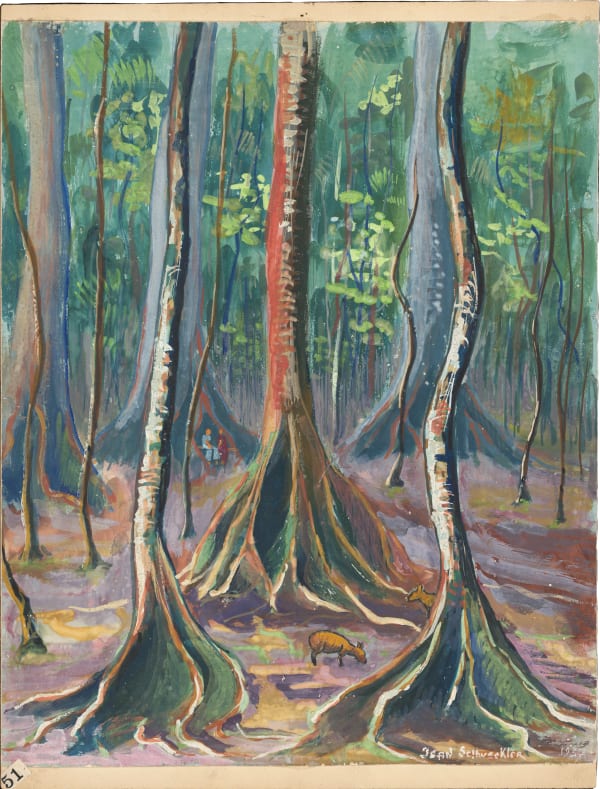In my beginning is my end.
— T.S. Eliot, East Coker
Hester Simpson was born in 1949 on Long Island and raised in the town of Locust Valley, where she spent her childhood in the company of her French grandparents, Ida and Jean Schweckler. Steeped in their language, their customs, their frugality, optimism, and love of nature, she developed an early affection for their way of life. Her grandfather, a painter, included her in his many activities in and around the studio. In their War World II Victory Garden, under an enormous apple tree, they gathered beets and rhubarb to boil down into a personal brand of alizarin crimson. Jean Schweckler’s paintings hung throughout the house from both walls and ceilings. The dining room, a mural of rubber-making in Brazil, covered the walls, replete with exotic flora and fauna, cerulean skies, trees and streams. Friends and neighbors regularly gathered for impromptu conversation and a glass of wine.
Today, decades after his passing, Simpson credits her grandfather's spirit with her own passion for her painting practice. My Grandfather’s Trees honors the profound connection she maintains with her childhood in Locust Valley. In the wake of her mother’s passing, she walks through Central Park to her studio and the trees “speak” to her. She snaps a photo, and for the first time uses photography to enlist their exact form as an expression of her present grief, as well as an homage to life. Trees, it seems, contain souls within; her family hidden in plain sight, here and now. Moving from her previous geometric abstraction, Simpson now employs a new vocabulary of arboreal forms. She works slowly and deliberately, layering intense color in acrylic paint, alternating between pouring and brushing, a technique she developed in the late 1990s. The result is an examination of biomorphic pattern with a nod to the preternatural, a quality that both reflects and affirms her premise of regeneration.
Photograph of the artist by Buck Ennis
-
"I remember the first time I drew with a purple crayon on my father’s shirt cardboard. I was four. I repeated the letter 'a' across the page and fell into a sort of rapture."
-
"I spent my childhood in Locust Valley in the company of my French grandparents, Jean and Ida Schweckler. I can say that it all started with them. Steeped in their language, their habits, their frugality, their optimism, and love of nature, their home was my sanctuary."
-
"My grandparents lived near our house and welcomed us at all times. Their home was filled with paintings and objects from their travels. In 1936, my grandfather jumped on a tramp steamer to visit South America and record its visual wonders in paint."
-
"In the late 1990s, at a crossroads in my painting, I had a dream ... I was in my studio with a number of projects scattered around me. Suddenly, Paul Ha, to whom I had recently shown my work at White Columns, walked into the room and pointed to a palette containing four colors: purple, green, yellow and brown. He said: 'these are your colors'"
-
"As I grieved, I began to notice the trees I passed on my walks to and from my studio. On the Literary Walk in Central Park, they seemed to reach out to me, as if to console me."
-
"The idea of using a photograph in my painting process presented a quantum leap, as I had been taught that to draw from life is sacrosanct and that nothing else would do..."
-
"While I am enamored of the glorious brushstrokes, washes, and scumblings of other painters, they are a distraction to my focus on form and color."
-
"The trees I celebrate in this exhibit are rooted in past and present. Some are 'tree portraits,' like Pins Parapluies from 1912 which my grandfather painted in Corsica during his military service. One of these is a 70 year-old dogwood from my childhood home which still blooms pink every spring."
-
"Trees find innumerable ways of colliding with one another to form visual patterns of stunning complexity. My grandfather’s Pousse-Lorys and Mirador du Chasseur de Papillons, filled with layered vines, acknowledge his own fascination with this phenomenon. While he and I share the awe of these arboreal gymnastics, we part ways as he engages the viewer with Daumier-esque humor ... My Pink Jungle, on the other hand, is a cerebral exploration of form and color."
-
"For me, painting is a still art about space. It requires time and intimacy. I work slowly and carefully. Moments expand. While thoughts of the everyday waft through my head ... It all started with my grandparents. It is they who created the fertile ground for encouraging what would carry me through life, what would feed my soul."
-
Jean Schweckler
-
 Mirador Du Chasseur De Papillons, 1937India ink and white gouache on paper10 1/2 x 14 in. (26.7 x 35.6 cm)(JS 04)NFS
Mirador Du Chasseur De Papillons, 1937India ink and white gouache on paper10 1/2 x 14 in. (26.7 x 35.6 cm)(JS 04)NFS -
 Pousse Lorys, 1937India ink and white gouache on paper8 1/2 x 14 in. (21.6 x 35.6 cm)(JS 02)NFS
Pousse Lorys, 1937India ink and white gouache on paper8 1/2 x 14 in. (21.6 x 35.6 cm)(JS 02)NFS -
 Amazon, 1937Gouache on paper board12 1/2 x 16 1/2 in. (31.8 x 41.9 cm)(JS 03)NFS
Amazon, 1937Gouache on paper board12 1/2 x 16 1/2 in. (31.8 x 41.9 cm)(JS 03)NFS -
 Pins Parapluies, 1912Watercolor on paper10 3/4 x 8 1/2 in. (27.3 x 21.6 cm)(JS 01)NFS
Pins Parapluies, 1912Watercolor on paper10 3/4 x 8 1/2 in. (27.3 x 21.6 cm)(JS 01)NFS
-
-
Simpson studied at Carnegie-Mellon University and Cranbrook Academy of Art. She has been a visiting artist at The School of the Art Institute of Chicago, The Tyler School of Art, and The School of the Museum of Fine Arts in Boston, among others. Upon settling in New York in 1985, Simpson was drawn to teaching persons with disabilities, and embarked upon a career as a Visual Arts Workshop Leader and Evaluator of workshop programs for the culturally underserved.
Simpson is represented by more than 30 works in the William Louis-Dreyfus Family Collection, where she participated in collaborative teaching workshops with The Harlem Children’s Zone. She is the recipient of numerous awards including a Gottlieb Foundation Grant, a Wolf-Kahn Exhibition Grant and three residencies at The Helene Wurlitzer Foundation of New Mexico, which transformed her sense of light and color, influencing her painting to this day.
Simpson exhibits her work internationally and had has had five solo shows at Ricco/Maresca. Phyllis Braff of The New York Times describes her work as “mesmerizing.”
-
Concurrently on view in Gallery Two:
Coming Attractions Vol. 1
Visit the online viewing room here.

